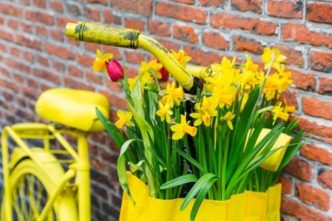
Pass the Rhizomes Please…It’s Fun to Share Bearded Iris
Sharing divided Bearded Iris with family and friends is a tradition among gardeners all over the country. One customer comes to mind, who nurtures her Bearded Iris from her great grandmother, that grandma planted before our customer was born—a special garden treasure. Why not start your own tradition?
With Just a Little Know-How, You Can Grow Bearded Iris for Generations to Come

Bearded Iris are native to Central and Southern Europe. The word “Iris” means “Rainbow” in Greek—which makes sense—as there is literally every color of the rainbow available in iris rhizome form.A show-stopper after tulips, daffodils are finished blooming, Bearded Iris bloom late spring through summer—depending on the cultivar—and offer a dramatic show of four-to-eight-inch flowers.
What’s a Rhizome?
A rhizome is a long, bumpy root that grows horizontally. Plant them so they are exposed slightly above the soil. From the rhizome, the iris shoots up.
Let’s Talk Falls, Beards, and Fans
Bearded Iris flowers are composed of three flower parts that droop downwards and are commonly called “falls”. The common name of the Bearded Iris comes from the “beards” that appear on each of the falls of the flower. The leaves look like, and are often called, “fans”.
A Little Sun, A Little Water, and A Little Amendment

Bearded Iris only do well in a sunny location—at least six hours of direct sun each day—like western or southern exposure. The rhizomes love well-drained soil. If your soil is too compact and mostly clay, simply mix a soil amendment into your beds—GreenAll FirMulch™ or G&B Organics® Planting Compost—at least six inches deep.
Planting Tips
- Plant rhizomes September through early November. After that, they are not likely to be very successful.
- Plant bulbs 12-18 inches apart. Allow for your plants grow 4-48″ tall.
- Barely cover the rhizome roots with soil. Planting rhizomes too deep will cause rot.
- Set the top of the rhizome so it is exposed to the sun.
- Water newly planted rhizomes immediately. Once established, rhizomes can be watered less frequently. Once established the plants will thrive on less frequent, but deep watering. Avoid frequent, shallow watering, as it may cause rot.
- Fertilize three times a year:
- After green growth appears—late winter or early spring—apply bulb food or an organic all-purpose fertilizer.
- After the plant blooms again with either bulb food or organic all-purpose fertilizer.
- In fall, fertilize with 0-10-10.
- Divide every three or four years when the rhizomes become overcrowded. Dividing helps maintain healthy plants, which keeps them blooming. Simply dig them up, cut into sections with a sharp knife, and replant individually or in groups.
- Deadhead old flowers so the plant can shift energy to make new rhizomes for next season’s bloom.
Bearded Iris Make Nice Companions

When selecting companion plants for your Bearded Iris, be sure to include water-wise options that require drier soils and sunny locations. Perfect companion plants are Echinacea, Coreopsis, Santolina, Lavender, Gaillardia, Gaura, Rudbeckia, and many grasses. Iris grow in most locations in the United States, and make a great legacy gift you can pass on for generations. Nothing is prettier than a garden of different Iris cuttings in all the colors of the rainbow.
Best Bet – Dark blue/white
Chasing Rainbows – light lavender with yellow accents
City Lights – Blue with white splotch
Clarence – Sky Blue and white
Concertina – White with light blue accents
Earl of Essex – Dark blue and white
Feedback – Dark purple with white splotches
Firebreather – Orange
Goldkist – White with a kiss of gold
Harvest of Memories – Chiffon yellow
Jurassic Park – Deep yellow and dark purple
Mariposa Autumn – Dark lavender and white
